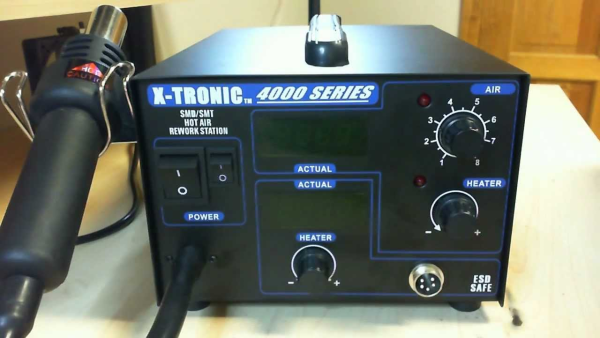Table of Contents
Hot Air Rework Tool Tutorial
- Model: X-Tronic 4040 Hot Air Rework Station
- Manufacturer: X-Tronic
- Documentation: Obsolete, link to 4040 Pro-X Manual
Prerequisites
Electronics Area Clearance
Warnings
⚠️ The air coming out of the rework station is hot enough to burn and to catch things on fire always be mindful in where the air it’s making is going.
⚠️ Solder may contain Lead, Always use proper ventilation or fume extraction when working with the soldering equipment. Flux vapors can also be irritating to people.
🚫Do not leave the rework station plugged in when not in use.
Tool Anatomy
Soldering Safety Guidelines
General Soldering Safety
<ol style=“list-style-type: decimal;”>
- Never touch the nozzle end of the rework wand.
- Hold wires to be heated with tweezers or clamps.
- Always return the rework wand to it’s stand when not in use. Never put it down on your workbench. Be sure that the stand is weighted enough or attached to your work table so that it doesn’t topple over if you brush against the cord.
- Turn the unit off or unplug it when not in use.
- Different boards and solders need different temperatures don’t start out too hot
- Give any soldered surface a minute or two to cool down before you touch it.
</ol>
Work Safely with Solder, Flux, and Cleaners
- Wear eye protection. Solder can “spit” (an air pocket or impurity can pop as you heat the solder and send bits of solder flying).
- Use lead free solder.
- Keep cleaning solvents in dispensing bottle to reduce inhalation hazards.
- Always wash your hands with soap and water after soldering.
- Read and understand the MSDS (Material Safety Data Sheets) for all materials before beginning work (e.g., http://jr.chemwatch.net/chemwatch.web/account/login).
Dangers of Lead Exposure
Lead (http:%%//%%www.cdc.gov/niosh/topics/lead/) on your skin can be ingested and lead fumes can be given off during soldering. Other metal (https://www.osha.gov/SLTC/metalsheavy/index.html) fumes can also be hazardous. Lead can have serious chronic health effects, such as reproductive problems, digestive problems, nerve disorders, memory and concentration problems, muscle and joint pain.
Avoid Toxic Fumes
- Work in a well‐ventilated area, to prevent the mildly caustic and toxic fumes from building up and causing eye or throat irritation.. The smoke formed is mostly from the flux which can be irritating, a sensitizer and aggravates asthma. Avoid breathing it by keeping your head to the side of, not above, your work.
- A benchtop fume extractor may be necessary to remove harmful fumes caused by solder and flux from the soldering workstation by filtering the air. If the lab is equipped with a snorkel fume extractor, always use it when soldering.
Reduce Risk From Electricity
- Always use a grounded outlet and grounding prong to reduce the risk of electrical damage if a short circuit occurs in the equipment.
- Prevent damage to electrical cords during soldering. Keep them away from where the nozzle is pointed.
- Never use on a live circuit (one that is energized).
Fire Prevention
- Work on a fire‐proof or nonflammable surface that is not easily ignited.
- Never place a the wand on your work surface: you could start a fire. Never leave flammable items (such as paper) near your rework station.
- Wear nonflammable or 100% cotton clothing that covers your arms and legs to help prevent burns.
- Know where your fire extinguisher is and how to use it.
First Aid
- Immediately cool the affected area under cold water for 15 minutes.
- Do not apply any creams or ointments. Cover with a band‐aid.
- Seek medical attention if the burn covers an area bigger than 3 inches across.
Waste
- Discard lead and silver solder and dross in a container with a lid.
- Label the container: “Lead (Silver) Solder Waste for Recycling”.
- Used solder sponges and contaminated rags must be disposed of as hazardous waste.
- Keep a lid on waste solder containers when not adding or removing material.
Tool Care
Inspection
- Ensure that the cables are in good shape and the insulation is not broken or fraying.
- Ensure your workspace is clear from debris and clutter.
- Ensure that the nozzle is fastened securely.
Cleaning
Wipe down the work area with a damp cloth and dispose of all scraps.
Maintenance Requests
If you encounter any of the issues listed in the Inspection area or have any other issues with the tool not working properly
- Update the physical Maintenance Tag at the machine
🟢Green can be used without issue
🟡Yellow can be used with caution
⛔Red cannot be used without hazard to either the user or the equipment
- Record issues at protohaven.org/maintenance. This notifies our staff and volunteer maintenance crew of any issues.
Recommended Procedure
Nozzle Selection
You will want to select a nozzle that directs the air to where you need it.
Additional Resources
Staff Use
| ⚠️ AUTHORIZED MAINTENANCE GROUP ONLY |
If you are part of the maintenance group please log on to the #maintenance channel of our Discord server to:
- Perform a Maintenance Action
- Request a Maintenance Purchase
- Review complete Maintenance Logs for each machine
- Generally chit-chat about maintenance
Every Walkthrough:
⚠️Ensure the rework station is off and unplugged when not in use. Especially when closing up for the night.
Regular Maintenance
| === Hippocratic Oath === * Start with the Manual * Ask questions * Do no harm * Know your limits * Document your actions |

